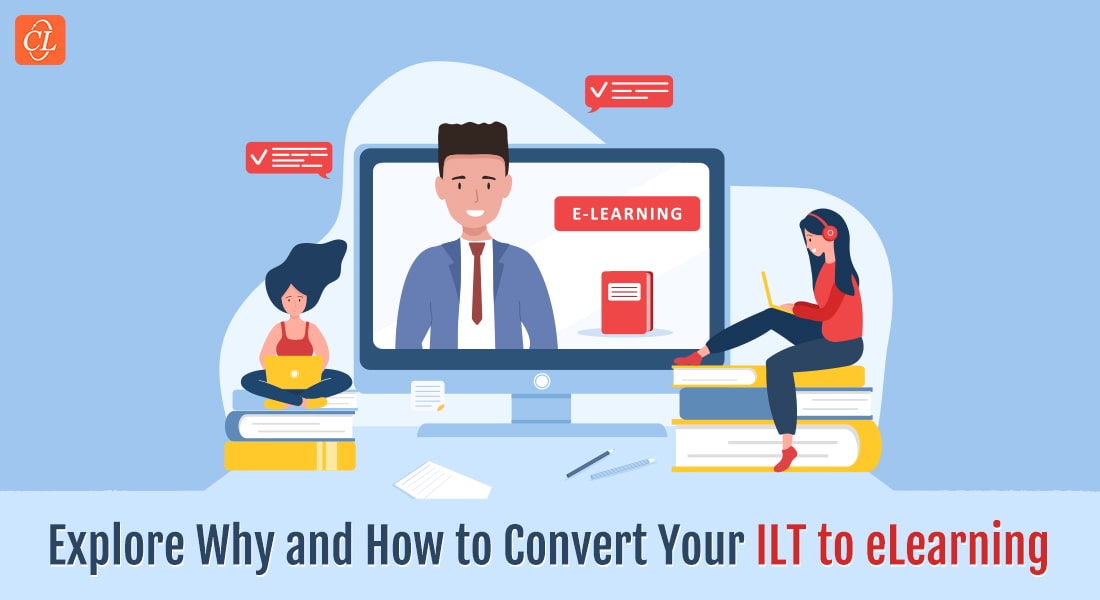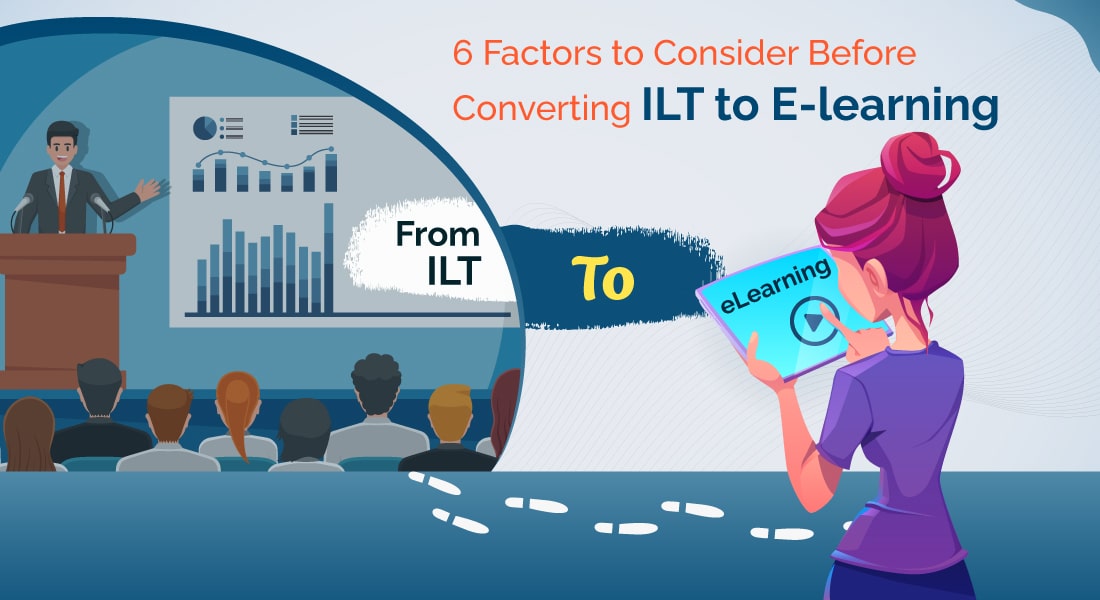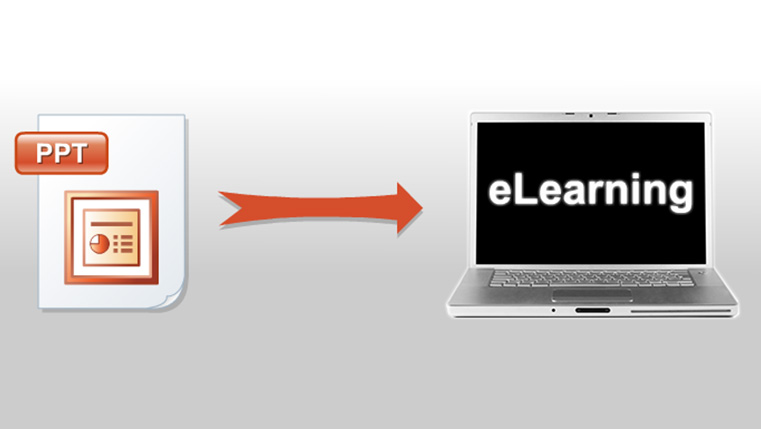Why Organizations Should Prioritize ILT To eLearning Conversion
The recent pandemic has pushed the learners back into their homes, and now, even when the lockdown has ended, the training preferences have changed and ILT is no longer a part of it. Explore why and how you should convert your ILT to eLearning.

The world of learning has undergone a revolutionary change in recent years, with technology transforming the way we acquire knowledge. Gone are the days of stuffy classrooms and rigid schedules, as eLearning has taken center stage, offering a flexible and convenient way to learn. But for many organizations, the transition from traditional Instructor-Led Training (ILT) to eLearning has been a slow process. The truth is, the need for this conversion is greater than ever before. The benefits of eLearning are numerous, from increased accessibility and reach, to cost savings for organizations. It’s time for organizations to embrace the future of learning and make the switch from ILT to eLearning.
Do You Want to Convert ILT to eLearning Seamlessly?
These tips and best practices might help you –
- Assess your training needs
- Evaluate existing course content and materials
- Adopt a learner-centered design approach
- Incorporate interactive elements
- Ensure accessibility and compatibility across devices
Read on to understand why it is necessary to convert ILT to eLearning.
Why Should you Convert ILT into eLearning?
1. Flexibility
eLearning provides learners with the flexibility to complete coursework at their own pace and schedule, without having to attend live sessions or be in a specific location. They can access the eLearning courses on mobiles which enhances learner convenience. You can also incorporate various modern learning strategies to design your eLearning courses so that you can deal with distinct learner preferences.
2. Efficiency
eLearning can be more cost-effective for organizations, as it eliminates the need for physical classrooms, instructors, and other resources associated with traditional ILT. Considering the fact that you are converting from ILT to eLearning, you must have multiple classroom training materials, so you can reuse these assets within your eLearning courses and make the development process more efficient.
3. Scalability and Accessibility
eLearning can reach a wider audience, as it can be accessed from anywhere with an internet connection after you have hosted these courses on your learning management systems(LMS). This is specifically crucial for organizations with remote or global employees. Some of the modern LMS platforms have an option to access these courses offline after you download them, so even if you don’t have a stable internet connection, you can still access your training effectively.
Access Your Free Guide to Choosing the Right Learning Management Systems!
Challenges Faced While Converting ILT to eLearning
1. Content creation and design
Converting from ILT to eLearning involves rethinking how content is presented and designed for online delivery. It is important to consider how to make online content engaging, interactive, and effective for learners. You can use various new-age learning strategies such as gamification, scenario-based learning, and microlearning to enhance the engagement and effectiveness of your eLearning courses.
2. Technical considerations
The technical aspect of eLearning can be challenging, particularly for organizations that are new to it. Considerations include software and hardware requirements, compatibility across devices, and security issues. To create a basic eLearning course from your ILT assets and deliver it to your workforce, you need an authoring tool, LMS, and a bunch of AI tools to accelerate the process.
3. Ensuring learner engagement
Online learning can be less interactive than traditional ILT if you convert it right away without focusing on maximizing learner engagement. It is important to find ways to make eLearning content engaging and interactive to keep learners motivated and on track. Incorporating gamified assessments, interactive activities, and immersive learning strategies can make your eLearning modules more engaging and enhance learner participation and course completion rates.
Best Practices for Converting from ILT to eLearning
1. Assess your training needs
Before converting from ILT to eLearning, it is important to assess the needs of your learners and organization. This includes evaluating the existing training programs, identifying your target audience, and considering what changes are required.
2. Evaluate existing course content and materials
When converting from ILT to eLearning, always ensure you assess the existing course content and materials to determine what can be reused and what needs to be modified. For example, PDFs can be used as supplementary learning resources, PPT assets can be used as content slides, and content from various guides can be modified to design performance support assets.
3. Adopt a learner-centered design approach
eLearning design should be centered around the needs and preferences of the learners, rather than just focusing on the content. Following robust instructional design principles and incorporating modern learning strategies can help you develop learner-centric eLearning courses. This can help to increase learner engagement and motivation.
4. Incorporate interactive elements
Interactive elements such as quizzes, simulations, and games can help to keep learners engaged with the course in a fun and exciting way. They also provide opportunities for learners to apply what they have learned through various types of formative and summative assessments and receive relevant feedback instantly.
5. Ensure accessibility and compatibility across devices
eLearning should be accessible and compatible across a variety of devices, including desktops, laptops, tablets, and smartphones. This can help to ensure that learners can access the content when and where they need it. It is always advised to design entirely responsive courses instead of adaptive ones.
Parting Thoughts!
The conversion from ILT to eLearning can bring many benefits for learners and organizations, but it also involves careful planning and consideration. Organizations should start with a needs assessment, evaluate existing content and materials, adopt a learner-centered design approach, incorporate interactive elements, and ensure accessibility and compatibility across devices. I bet you are looking forward to getting started with eLearning and to help you out, you can grab this amazing eBook and pave your way to becoming an eLearning champion.





